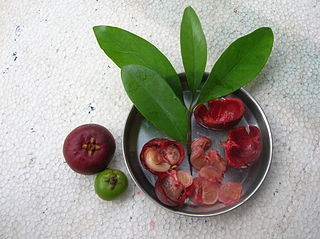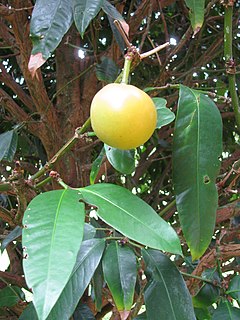
The Indomalayan realm is one of the eight biogeographic realms. It extends across most of South and Southeast Asia and into the southern parts of East Asia.

Mangosteen, also known as the purple mangosteen, is a tropical evergreen tree with edible fruit native to tropical lands surrounding the Indian Ocean. Its origin is uncertain due to widespread prehistoric cultivation. It grows mainly in Southeast Asia, southwest India and other tropical areas such as Colombia, Puerto Rico and Florida, where the tree has been introduced. The tree grows from 6 to 25 metres tall. The fruit of the mangosteen is sweet and tangy, juicy, somewhat fibrous, with fluid-filled vesicles, with an inedible, deep reddish-purple colored rind (exocarp) when ripe. In each fruit, the fragrant edible flesh that surrounds each seed is botanically endocarp, i.e., the inner layer of the ovary. Seeds are both almond-shaped and -sized.

Garcinia is a genus of flowering plants in the family Clusiaceae native to Asia, America, Australia, tropical and southern Africa, and Polynesia. The number of species is disputed; the Kew Gardens recognise up to 400. Commonly, the plants in this genus are called saptrees, mangosteens, garcinias, or monkey fruit.

Malesia is a biogeographical region straddling the Equator and the boundaries of the Indomalayan and Australasian realms, and also a phytogeographical floristic region in the Paleotropical Kingdom. It has been given different definitions. The World Geographical Scheme for Recording Plant Distributions split off Papuasia in its 2001 version.

Hibiscus tiliaceus is a species of flowering tree in the mallow family, Malvaceae, that is native to the Old World tropics. Common names include sea hibiscus, beach hibiscus, coastalhibiscus, coastalcottonwood, green cottonwood, native hibiscus, native rosella, cottonwood hibiscus, kurrajong, sea rosemallow, balibago (Tagalog), malabago or malbago, maribago, lambago, waru (Javanese), baru or bebaru (Malay), pagu (Chamorro), hau (Hawaiian), fau (Samoan), purau (Tahitian), and vau tree. The specific epithet, "tiliaceus", refers to its resemblance of the leaves to those of the related Tilia species.

Garcinia gummi-gutta is a tropical species of Garcinia native to Indonesia. Common names include Garcinia cambogia, as well as brindleberry, Malabar tamarind, Goraka (ගොරකා), and kudam puli. The fruit looks like a small pumpkin and is green to pale yellow in color.

Lecanorchis is a genus of orchids belonging to the subfamily Vanilloideae.

Garcinia kola (bitter kola is a species of flowering plant belonging to the Mangosteen genus Garcinia of the family Clusiaceae. It is found in Benin, Cameroon, Democratic Republic of the Congo, Ivory Coast, Mali, Gabon, Ghana, Liberia, Nigeria, Senegal and Sierra Leone. Its natural habitat is subtropical or tropical moist lowland forests.

The Ryukyu flying fox or Ryukyu fruit bat is a species of megabat in the family Pteropodidae. It is found in Japan, Taiwan, and the Batanes and Babuyan Islands of the Philippines. Its natural habitats are subtropical or tropical dry forests and subtropical or tropical swamps. It is threatened by habitat loss and by hunting for food and the IUCN classify it as "Vulnerable".

Garcinia dulcis is a tropical fruit tree native to the Philippines, eastern Indonesia, and Papua New Guinea. It was domesticated early and spread inland into mainland Asia. It is commonly known as mundu or munu in Indonesia and Malaysia, baniti or taklang-anak in the Philippines, and maphuut or ma phut in Thailand.

The flora of China consists of a diverse range of plant species including over 39,000 vascular plants, 27,000 species of fungi and 3000 species of bryophytes. More than 30,000 plant species are native to China, representing nearly one-eighth of the world's total plant species, including thousands found nowhere else on Earth. China's land, extending over 9.6 million km, contains a variety of ecosystems and climates for plants to grow in. Some of the main climates include shores, tropical and subtropical forests, deserts, elevated plateaus and mountains. The events of the continental drift and early Paleozoic Caledonian movement also play a part in creating climatic and geographical diversity resulting in high levels of endemic vascular flora. These landscapes provide different ecosystems and climates for plants to grow in, creating a wide variety of different flora spanning over not just China but different parts of the world now.

Garcinia indica, a plant in the mangosteen family (Clusiaceae), commonly known as kokum, is a fruit-bearing tree that has culinary, pharmaceutical, and industrial uses.

Smilax china is a climbing plant species in the genus Smilax. It is native to China, Korea, Taiwan, Japan, Philippines, Vietnam, Thailand, Myanmar, and Assam. Common names for the plant include China root.

Garcinia warrenii, a is a fruit-bearing tree, up to 15 metres in height, of the mangosteen family (Clusiaceae), commonly known as native mangosteen or Warren's mangosteen. It is found in the tropical rainforests of northern and north-eastern Australia and New Guinea. The genus Garcinia, belonging to the family Clusiaceae, includes about 200 species found in the Old World tropics, mostly in Asia and Africa. Garcinia warrenii is indigenous to New Guinea, the Torres Strait Islands, northeastern Queensland from Cape York Peninsula south to Babinda, and a small, isolated population on Melville Island in the Northern Territory, Australia.
Garcinia loureiroi is a tree species in the family Clusiaceae. The Catalogue of Life lists no subspecies.
Garcinia celebica is an accepted name of a tree species in the family Clusiaceae. The Catalogue of Life lists no subspecies.
Garcinia multiflora is a tree species in the family Clusiaceae. No subspecies are listed in the Catalogue of Life.
Garcinia nigrolineata has been called "wild beaked Kandis" and is a tree species in the family Clusiaceae. The Catalogue of Life lists no subspecies.
Garcinia binucao is a species of flowering plant in the Clusiaceae family. It is commonly known as binukaw or batuan, is a species of Garcinia endemic to the Philippines. It is not cultivated, though its edible fruits are harvested from the wild for use as a souring agent in some Filipino dishes.

Garcinia xanthochymus, the false mangosteen, gamboge, yellow mangosteen, Himalayan Garcinia, or Sour Mangosteen is a species of mangosteens found from India, southern China, and Japan through Indochina to Peninsular Malaysia at elevations of 0 - 1400 meters. Plants are found growing in humid forests of valleys or on hills. It's locally known as Defol (ডেফল) in Bengal; Tepor Tenga in Assam; and Heirangoi (হৈরাংগোই) in Manipur.















